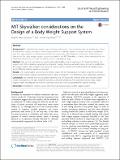| dc.contributor.author | Krebs, Hermano Igo | |
| dc.contributor.author | Sales Goncalves, Rogerio | |
| dc.date.accessioned | 2017-09-15T18:58:30Z | |
| dc.date.available | 2017-09-15T18:58:30Z | |
| dc.date.issued | 2017-09 | |
| dc.date.submitted | 2016-10 | |
| dc.identifier.issn | 1743-0003 | |
| dc.identifier.uri | http://hdl.handle.net/1721.1/111570 | |
| dc.description.abstract | Background
To provide body weight support during walking and balance training, one can employ two distinct embodiments: support through a harness hanging from an overhead system or support through a saddle/seat type. This paper presents a comparison of these two approaches. Ultimately, this comparison determined our selection of the body weight support system employed in the MIT-Skywalker, a robotic device developed for the rehabilitation/habilitation of gait and balance after a neurological injury.
Method
Here we will summarize our results with eight healthy subjects walking on the treadmill without any support, with 30% unloading supported by a harness hanging from an overhead system, and with a saddle/seat-like support system. We compared the center of mass as well as vertical and mediolateral trunk displacements across different walking speeds and support.
Results
The bicycle/saddle system had the highest values for the mediolateral inclination, while the overhead harness body weight support showed the lowest values at all speeds. The differences were statistically significant.
Conclusion
We selected the bicycle/saddle system for the MIT-Skywalker. It allows faster don-and-doff, better centers the patient to the split treadmill, and allows all forms of training. The overhead harness body weight support might be adequate for rhythmic walking training but limits any potential for balance training. | en_US |
| dc.publisher | BioMed Central | en_US |
| dc.relation.isversionof | http://dx.doi.org/10.1186/s12984-017-0302-6 | en_US |
| dc.rights | Creative Commons Attribution | en_US |
| dc.rights.uri | http://creativecommons.org/licenses/by/4.0/ | en_US |
| dc.source | BioMed Central | en_US |
| dc.title | MIT-Skywalker: considerations on the Design of a Body Weight Support System | en_US |
| dc.type | Article | en_US |
| dc.identifier.citation | Gonçalves, Rogério Sales and Krebs, Hermano Igo. "MIT-Skywalker: considerations on the Design of a Body Weight Support System." Journal of NeuroEngineering and Rehabilitation 14 (September 2017): 88 © 2017 The Author(s) | en_US |
| dc.contributor.department | Massachusetts Institute of Technology. Department of Mechanical Engineering | en_US |
| dc.contributor.mitauthor | Sales Goncalves, Rogerio | |
| dc.relation.journal | Journal of NeuroEngineering and Rehabilitation | en_US |
| dc.eprint.version | Final published version | en_US |
| dc.type.uri | http://purl.org/eprint/type/JournalArticle | en_US |
| eprint.status | http://purl.org/eprint/status/PeerReviewed | en_US |
| dc.date.updated | 2017-09-10T03:25:15Z | |
| dc.language.rfc3066 | en | |
| dc.rights.holder | The Author(s). | |
| dspace.orderedauthors | Gonçalves, Rogério Sales; Krebs, Hermano Igo | en_US |
| dspace.embargo.terms | N | en_US |
| mit.license | PUBLISHER_CC | en_US |
